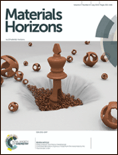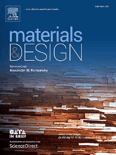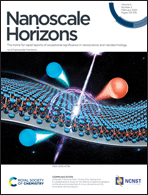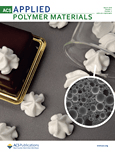
Materials Horizons
metrics 2024
Unveiling Cutting-Edge Discoveries in Material Engineering
Introduction
Materials Horizons is a prestigious academic journal published by the Royal Society of Chemistry, dedicated to the rapid dissemination of high-quality research in the fields of materials science and engineering. With its current impact factor positioning it in the Q1 category across multiple disciplines—including Electrical and Electronic Engineering, Materials Science, Mechanics of Materials, and Process Chemistry and Technology—this journal stands out as a leading voice in the scientific community. Featuring a broad scope that spans innovative materials development and processing techniques, Materials Horizons serves as a vital platform for researchers, professionals, and students alike, facilitating the exchange of cutting-edge ideas and methodologies. Access to its content, while not open-access, is available via institutional subscriptions or personal purchases, ensuring that high-quality research remains accessible to those in academia and industry alike. With an impressive Scopus rank—#12 in Mechanics of Materials and #4 in Process Chemistry—this journal continues to impact the synthesis and application of advanced materials, highlighting its commitment to fostering scientific advancement and collaboration.
Metrics 2024
 3.38
3.38 12.20
12.20 12.50
12.50 131
131Metrics History
Rank 2024
Scopus
IF (Web Of Science)
JCI (Web Of Science)
Quartile History
Similar Journals

MATERIALS & DESIGN
Elevating Knowledge in Materials and DesignMATERIALS & DESIGN is an esteemed academic journal published by Elsevier Science Ltd, distinguished in the fields of Materials Science, Mechanical Engineering, and Mechanics of Materials. With a robust impact factor and ranking in the top quartiles for 2023, it stands as a leading source for cutting-edge research in these disciplines, occupying ranks of #24 in Mechanical Engineering, #19 in Mechanics of Materials, and #45 in General Materials Science according to Scopus metrics. With an open access policy established in 2019, MATERIALS & DESIGN facilitates the broad dissemination of knowledge, promoting collaboration and innovation among researchers, professionals, and students alike. The journal covers a diverse array of topics, providing vital insights into materials and design methodologies that foster advancements in technology and engineering. Operating from the Netherlands, MATERIALS & DESIGN continues to be a pivotal platform for transformative research, encouraging contributions that drive the future of material design and engineering.

ADVANCED FUNCTIONAL MATERIALS
Exploring New Frontiers in Materials ScienceADVANCED FUNCTIONAL MATERIALS is a leading journal published by WILEY-V C H VERLAG GMBH, prominently recognized in the fields of biomaterials, chemistry, condensed matter physics, and materials science. With an impressive impact factor and a distinguished position in the Q1 quartile across multiple categories including nanoscience and nanotechnology, this journal serves as a vital platform for researchers and professionals committed to innovating in functional materials. Since its inception in 2000, ADVANCED FUNCTIONAL MATERIALS has published high-quality peer-reviewed articles that push the boundaries of materials science, exploring new frontiers in electronic, optical, and magnetic materials. The journal's dedication to open access ensures that its groundbreaking findings are readily available to a global audience, fostering collaboration and knowledge-sharing among scholars and practitioners in the field. For those seeking to stay at the forefront of materials research, ADVANCED FUNCTIONAL MATERIALS is an essential resource.

ADVANCED MATERIALS
Connecting Ideas, Driving Innovation in Materials ScienceAdvanced Materials, published by Wiley-VCH Verlag GmbH, is a premier academic journal that serves as a crucial platform for cutting-edge research in the field of materials science and engineering. With an impressive impact factor and ranking among the top tiers in various categories, including Materials Science, Mechanical Engineering, and Nanoscience, this journal is recognized for its high-quality contributions and relevance to contemporary research challenges. Spanning from 1989 to 2024, Advanced Materials not only features groundbreaking studies but also provides insights into innovative applications and advancements in material design and engineering. Researchers, professionals, and students alike will benefit from the rigorous peer-review process and diverse range of topics covered, making it an indispensable resource for those aiming to stay at the forefront of materials science innovation.

Nanoscale Horizons
Pioneering Discoveries in NanotechnologyNanoscale Horizons is an esteemed journal published by the Royal Society of Chemistry, focusing on cutting-edge research in the field of nanoscale materials and their applications. Established in 2016, this journal quickly gained prominence, achieving a Q1 ranking in Materials Science (miscellaneous) and a notable rank of #32 out of 463 in the Scopus index, placing it in the 93rd percentile among its peers. With its rigorous peer-review process and commitment to disseminating high-impact research, Nanoscale Horizons serves as a vital platform for sharing innovative discoveries and interdisciplinary advancements. Researchers and professionals are invited to explore the exciting developments in nanotechnology through this publication, fostering collaboration and knowledge exchange in an ever-evolving field. Though currently not open access, the journal ensures that significant research findings are made available to a diverse audience keen on advancing materials science.

ACS Applied Polymer Materials
Innovating Materials, Transforming ApplicationsACS Applied Polymer Materials is a prestigious journal published by the American Chemical Society, specifically tailored for the dynamic fields of Organic Chemistry, Polymers and Plastics, and Process Chemistry and Technology. With its ISSN 2637-6105, the journal has rapidly established itself within the academic community, achieving a distinguished Q1 quartile ranking across multiple categories in 2023. This places it among the top-tier journals globally, reinforcing its critical role in disseminating groundbreaking research and innovation in polymer science. The journal is known for its rigorous peer-review process and publishes high-quality articles that are pivotal for researchers, professionals, and students eager to advance knowledge in polymer materials and their applications. Positioned to cover converging themes from 2019 through 2024, ACS Applied Polymer Materials embraces a wide scope of studies, from fundamental chemistry to practical engineering applications, thereby fostering significant advancements in material science. While it offers traditional access options, the journal's impact is reflected in its impressive rankings within Scopus, indicating its relevance and influence in the chemical engineering domain. Join the global community of innovators and discover the latest insights that continue to shape the landscape of applied polymer research.

JOURNAL OF POLYMER RESEARCH
Unveiling Cutting-Edge Research in PolymersJOURNAL OF POLYMER RESEARCH is a leading peer-reviewed journal published by SPRINGER, specializing in the dynamic fields of polymer science, materials chemistry, and organic chemistry. Operating since 1994, this esteemed journal has consistently delivered high-quality research articles that illuminate the latest advancements and innovations in polymer technology. With an increasing impact factor and placed in the Q2 category for both Materials Chemistry and Polymers and Plastics, it stands as a valuable resource for researchers, professionals, and students seeking cutting-edge knowledge in these areas. The journal is indexed in Scopus, highlighting its significance in the academic community, with notable rankings in Materials Science and Organic Chemistry. While it does not currently offer open access options, the meticulous selection of research and thorough peer-review process ensures each article's contribution to the field is both robust and impactful. Researchers aiming to expand their understanding and engage with pioneering studies will find JOURNAL OF POLYMER RESEARCH an indispensable platform.

MACROMOLECULAR RESEARCH
Unlocking the Potential of Polymers WorldwideMACROMOLECULAR RESEARCH, published by the POLYMER SOC KOREA, is a premier journal dedicated to advancing the field of macromolecular science and polymer engineering. With its ISSN 1598-5032 and E-ISSN 2092-7673, this journal has emerged as a vital platform for researchers and professionals interested in the application and development of polymers across various domains. Based in South Korea and operating as an open-access resource since its inception in 2002, MACROMOLECULAR RESEARCH consistently ranks in the Q2 category across diverse fields such as Chemical Engineering, Materials Chemistry, and Organic Chemistry as per the latest 2023 metrics. Notably, it is recognized for its substantial contributions to polymery science, increasing its visibility and impact in global research. By providing a forum for original research articles, reviews, and innovative methodologies, this journal aims to foster collaboration and knowledge sharing among scientists, engineers, and students alike. Join a community that is at the forefront of polymer research by exploring the wealth of resources and cutting-edge studies featured in MACROMOLECULAR RESEARCH.

MATERIALS LETTERS
Bridging research and application in materials engineering.MATERIALS LETTERS, published by ELSEVIER, is a premier journal dedicated to the rapid dissemination of significant advances in the field of materials science and engineering. With an impressive impact factor and a solid reputation reflected in its ranking within the Q2 quartile of various categories such as Condensed Matter Physics, Materials Science, Mechanical Engineering, and Mechanics of Materials, it provides a platform for researchers, professionals, and students to share focused and innovative research findings from 1982 to the present. Despite being a subscription-based journal, its accessibility through institutional and personal subscriptions ensures a wide reach in the academic community. By presenting concise reports, the journal aims to bridge the gap between fundamental research and practical applications, highlighting the critical role of materials in technological advancement. The journal's ISSN is 0167-577X and the E-ISSN is 1873-4979. For researchers looking to publish their work or follow the latest trends in materials science, MATERIALS LETTERS stands as an essential resource, contributing significantly to the discourse in this dynamic field.

ADVANCES IN POLYMER TECHNOLOGY
Empowering Innovation in Polymer Science.ADVANCES IN POLYMER TECHNOLOGY is a premier open-access journal that has been at the forefront of innovation in the field of polymer science and engineering since its inception in 1981. Published by WILEY-HINDAWI, this journal serves as a vital platform for researchers, professionals, and students alike, facilitating the dissemination of cutting-edge research and applications in chemical engineering, organic chemistry, and polymers and plastics. With an impact factor that signifies its relevance and quality, the journal has achieved notable rankings, including Q2 in Chemical Engineering, and ranks within the top 30% of its category in multiple disciplines as of 2023. ADVANCES IN POLYMER TECHNOLOGY has embraced open-access publishing since 2019, ensuring that research findings are widely available to the global academic community. With its comprehensive coverage of topics related to polymer technology, this journal not only fosters scholarly exchange but also aims to bridge the gap between fundamental research and practical applications, thereby contributing significantly to advancements in materials science.

POLYMER ENGINEERING AND SCIENCE
Exploring the Science Behind PolymersPOLYMER ENGINEERING AND SCIENCE, published by WILEY, is a premier journal specializing in the field of polymer science and engineering. Since its inception in 1961, this journal has been at the forefront of disseminating high-quality research, focusing on various aspects of polymers and plastics, including their chemistry, properties, and applications. With an impressive impact factor, it ranks in the second quartile (Q2) across multiple categories, including Chemistry (Miscellaneous), Materials Chemistry, and Polymers and Plastics, showcasing the journal's significance and influence in these vital areas of research. Researchers and professionals in academia and industry will find the latest advancements and innovative methodologies in polymer science, making this journal an essential resource for those looking to stay updated on cutting-edge developments. While it does not currently support Open Access, its comprehensive scope and critical insights positioned it as a valuable platform for advancing knowledge and fostering collaboration within the polymer community. The journal’s office is located at 111 River St, Hoboken 07030-5774, NJ, United States, emphasizing its strong presence in the academic landscape.